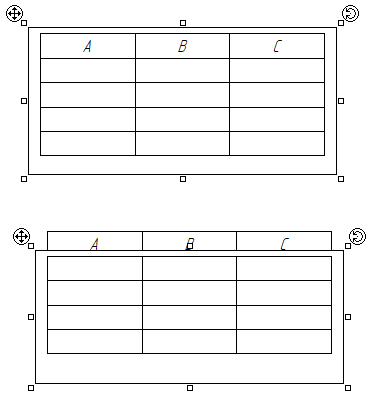Fit Settings of Paragraph Text |
  
|
When editing the content of paragraph text, you can call the Fit settings dialog using the following automenu option:
|
<Ctrl>+<F5> |
Change paragraph size parameters |
The dialog contains following tabs:
•Width
Sets the action to be applied by the system, in case when text content doesn't fit in width of a bounding rectangle.
•Height
Sets the action to be applied by the system, in case when text content doesn't fit in height of a bounding rectangle.
•Delete
Sets the action to be applied by the system, in case when deleting text content leaves a bounding rectangle empty.
•Additional
Allows duplicating headers of tables inserted into paragraph text.
The Ask action is selected by default in the Width, Height and Delete tabs. As a result, when the corresponding event occurs, a dialog will appear on the screen in which the user will be asked to choose a further action:
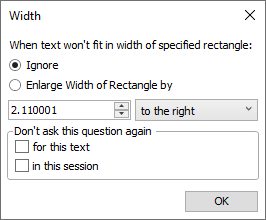
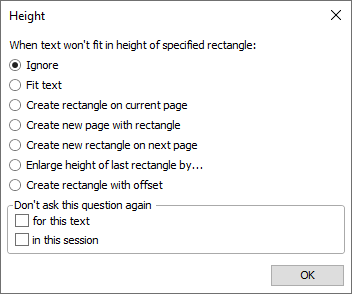
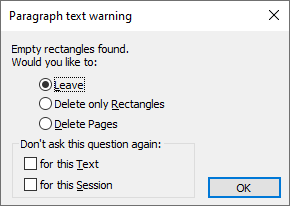
The set of actions available for selection in these dialogs is similar to the sets of actions available in the corresponding tabs of the Fit settings dialog.
Additionally, there's the Don't ask this question again group in the bottom part of the dialog containing following checkboxes:
•for this text
If this checkbox is enabled, then the action selected above will always be automatically applied to this text in the future. This flag takes precedence over the following.
•in this session
If this checkbox is enabled, then the action selected above will always be automatically applied to this text in the current T-FLEX CAD session. In following sessions the Ask action will be applied.
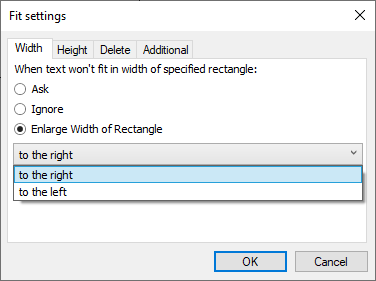
This tab sets the action to be applied by the system, in case when text content doesn't fit in width of a bounding rectangle:
•Ask
The system asks user to choose a further action.
•Ignore
Size of a rectangle remains unchanged. A content, that didn't fit, is still displayed on a drawing/WP and remains printable.
•Enlarge Width of Rectangle
Width of a rectangle is increased automatically, so that all text content fits. Upon selecting this action, the dropdown list appears in the bottom part of the dialog, where you can select a direction of extending a rectangle - to the right or to the left.
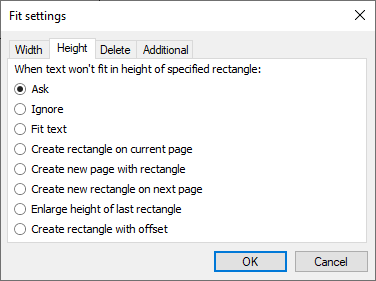
This tab sets the action to be applied by the system, in case when text content doesn't fit in height of a bounding rectangle:
•Ask
The system asks user to choose a further action.
•Ignore
Size of a rectangle remains unchanged. A content, that didn't fit, is not displayed on a drawing/WP outside the text content editing mode and becomes non-printable.
•Fit text
Font size shrinks, so that all text content fits a rectangle.
•Create rectangle on current page
A new rectangle is created automatically on a current page. Upon selecting this action, the Rectangle Coordinates input boxes appear in the bottom part of the dialog. Coordinates are set either in system of a page, or in system of a drawing view, depending on what the text belongs to.

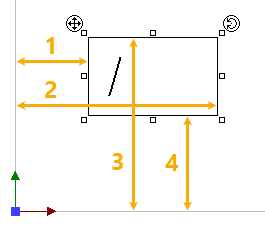
1 - Left, 2 - Right, 3 - Top, 4 - Bottom.
•Create new page with rectangle
A new rectangle is created automatically on a new page of the same type as the current page. Coordinates of a new rectangle are set in the same way as described above.
•Create new rectangle on next page
A new rectangle is created automatically on a next page. If there's no next page, it will be created automatically. Coordinates of a new rectangle are set in the same way as described above.
Regardless of the type of the page containing the initial rectangle, when adding a new rectangle, only pages of the following types are taken into account : ![]() Normal,
Normal, ![]() Text,
Text, ![]() Bill of Materials.
Bill of Materials.
•Enlarge height of last rectangle
Height of a rectangle is increased automatically, so that all text content fits. Upon selecting this action, the dropdown list appears in the bottom part of the dialog, where you can select a direction of extending a rectangle - downwards or upwards.

•Create rectangle with offset
A new rectangle is created automatically on the current page. A new rectangle is positioned by defining offsets of one of the angles of a new rectangle in relation to one of the angles of the initial rectangle (Bottom Left, Top Left, Top Right, Bottom Right).
Following parameters are available:
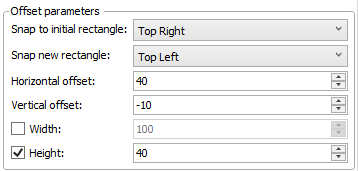
oSnap to initial rectangle
An angle of the initial rectangle, which will define a position of a new one.
oSnap new rectangle
An angle of a new rectangle, which is positioned in relation to an angle of the initial rectangle defined above.
oHorizontal offset and Vertical offset
Offset of a new rectangle from the initial one.
oWidth and Height
By default, dimensions of a new rectangle are equal to dimensions of the initial rectangle. So, dimension values are displayed in these input boxes but can not be edited. In order to type in custom value, enable the checkbox located to the left side of a corresponding parameter's name.

The result of creating a new rectangle with parameters shown on the previous image
1 - Top Right angle of the initial rectangle
2 - Top Left angle of the new rectangle
3 - Horizontal offset of the new rectangle from the initial one (40 mm)
4 - Vertical offset of the new rectangle from the initial one (-10 mm)
5 - Width of the new rectangle is defined by the width of the initial one (100 mm)
6 - Height of the new rectangle is defined by the custom value (40 mm)
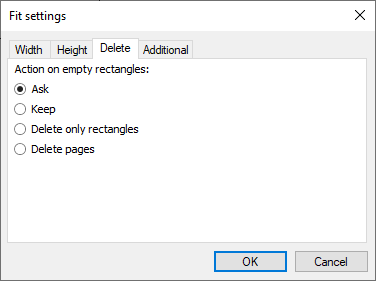
This tab sets the action to be applied by the system, in case when deleting text content leaves a bounding rectangle empty.
•Ask
The system asks user to choose a further action.
•Keep
Empty rectangle is kept.
•Delete only rectangles
Empty rectangle is deleted.
•Delete pages
The whole page containing the empty rectangle is deleted.
Attention! It doesn't matter if there's any other content on a page along with the empty rectangle. The page gets deleted anyway..
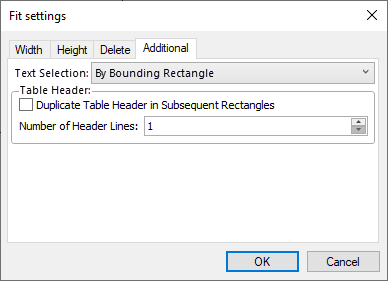
This tab allows to customize the text selection mode and behavior of a header of a table inserted into text on table hyphenation:
•Text Selection
Defines the result of pressing ![]() within text's bounding rectangle in the command standby mode. Following text selection modes are available in the drop-down list:
within text's bounding rectangle in the command standby mode. Following text selection modes are available in the drop-down list:
oBy Bounding Rectangle
Pressing ![]() over any part of text’s bounding rectangle launches the text content editing, regardless of regardless of whether this part is filled with content or not. This mode is default for generic texts.
over any part of text’s bounding rectangle launches the text content editing, regardless of regardless of whether this part is filled with content or not. This mode is default for generic texts.
oBy Content
Text content editing can be launched only by pressing ![]() directly over the content. This mode is default for drawing notes.
directly over the content. This mode is default for drawing notes.
•Table Header
If the Duplicate Table Header in Subsequent Rectangles checkbox is enabled, then, when a table inserted into text gets hyphenated into subsequent bounding rectangles, table's header is added to the top such rectangles. The header is the number of rows of the table from its beginning, specified in the Number of Header Lines input box.
This option only works for tables inserted at the beginning of the text. When inserting multiple tables into the same text, the header of the first table is displayed for all rectangles
